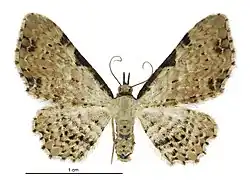Pasiphila fumipalpata
| Pasiphila fumipalpata | |
|---|---|

| |
| Female | |
| Scientific classification | |
| Kingdom: | Animalia |
| Phylum: | Arthropoda |
| Class: | Insecta |
| Order: | Lepidoptera |
| Family: | Geometridae |
| Genus: | Pasiphila |
| Species: | P. fumipalpata
|
| Binomial name | |
| Pasiphila fumipalpata | |
| Synonyms | |
| |
Pasiphila fumipalpata is a moth of the family Geometridae.[1] This species was first described by Baron Cajetan von Felder and Alois Friedrich Rogenhofer in 1875. It is endemic to New Zealand and has been observed on both the North and South Islands. However this species is regarded as rare. P. fulmipalpata inhabits native bush and adults are on the wing from December until February. They are attracted to light.
Taxonomy
This species was first described by Baron Cajetan von Felder and Alois Friedrich Rogenhofer in 1875 and originally named Eupithecia fumipalpata.[2] In 1898 George Hudson, thinking he was describing a new species, named this moth Chloroclystis maculata.[3] This name was synonymised with Chloroclystis fumipalpata by Alfred Philpott in 1926.[4] Hudson accepted this synonymisation and discussed and illustrated this species under the name Chloroclystis fumipalpata in his 1928 book The butterflies and moths of New Zealand.[5] In 1971 John S. Dugdale placed this species back in the genus Pasiphila.[6] The female holotype, collected by T. R. Oxley in Nelson, is held at the Natural History Museum, London.[7]
Description
.jpg)
George Hudson described the adults of this species as follows:
The expansion of the wings is about 7⁄8 inch. All the wings are creamy-white slightly tinged with warm brown or greenish-grey. The fore-wings have several irregular large black marks on the costa extending about two-thirds towards the apex; there is a curved transverse series of black dots at about two-thirds, and several irregular black marks on the termen near the middle and at the tornus. The termen of the hind-wings is irregular; there are numerous rows of black spots darkest near the dorsum. The cilia are cream-coloured strongly barred with black. All the wings have a wavy white subterminal line.[5]
Distribution
This species is endemic to New Zealand.[1] It is located in both the North and South Islands but is regarded as being relatively rare.[5]
Habitat and hosts
This species inhabits native forest.[5]
Behaviour
Adults are on the wing from December until February and are attracted to light.[5]
References
- ^ a b c "Pasiphila fumipalpata (Felder & Rogenhofer, 1875)". www.nzor.org.nz. Archived from the original on 2024-12-20. Retrieved 2025-08-06.
- ^ Felder, Cajetan; Rogenhofer, Alois Friedrich (1864–1867). "Reise der österreichischen Fregatte Novara". Reise der österreichischen Fregatte Novara um die Erde in den Jahren 1857, 1858, 1859 unter den Befehlen des Commodore B. Von W. pt.9:Bd.2:Abt.2 (1864-1867) Atlas: cxxxi fig 33 – via Biodiversity Heritage Library.
- ^ George Vernon Hudson (1898), New Zealand moths and butterflies (Macro-lepidoptera), Illustrator: George Hudson, London: West, Newman, & Co., pp. 44–45, doi:10.5962/BHL.TITLE.7912, OCLC 980865393, Wikidata Q19073637BHL page 7643693
- ^ A. Philpott (1926). "New Zealand Lepidoptera: Notes and Descriptions". Transactions and Proceedings of the New Zealand Institute. 56: 388. ISSN 1176-6158. Wikidata Q63100760.
- ^ a b c d e Hudson, G. V. (1928), The butterflies and moths of New Zealand, Illustrator: George Hudson, Wellington: Ferguson and Osborn Limited, p. 96, LCCN 88133764, OCLC 25449322, Wikidata Q58593286BHL page 61899707
 This article incorporates text from this source, which is in the public domain.
This article incorporates text from this source, which is in the public domain.
- ^ Dugdale, J. S. (10 November 1971). "Entomology of the Aucklands and other islands south of New Zealand: Lepidoptera, excluding non-crambine Pyralidae". Pacific Insects Monographs. 27: 106. ISSN 0078-7515. Wikidata Q64006453.
- ^ Dugdale , J. S. (23 September 1988). "Lepidoptera - annotated catalogue, and keys to family-group taxa". Fauna of New Zealand. 14. Department of Scientific and Industrial Research: 187. doi:10.7931/J2/FNZ.14. ISSN 0111-5383. Wikidata Q45083134.